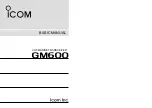
The Interface Solution Experts
35
THZ
2
&
TDZ
2
Programmable Smart HART
Temperature Transmitter and Display
Operation
Once programmed, calibrated, installed and supplied
with the correct power, THZ
2
and TDZ
2
transmitters
begin to operate immediately. Depending upon envi-
ronmental conditions, they can be expected to operate
unattended for extended periods of time.
HART Protocol
This section of the manual gives an overview of the
HART format used by THZ
2
and TDZ
2
modules dur-
ing operation. Use the information in this section to
process the data provided by the module(s) during op-
eration. For more information on the HART protocol,
contact the HART Foundation at:
HART Communication Foundation
9390 Research Blvd., Suite I-350
Austin,
TX
78759-6540
USA
Phone: (512) 794-0369
Fax: (512) 794-3904
www.hartcomm.org
Device Types
To implement two-way communication between the
THZ
2
and the device being used to configure it or re-
ceive its information, the THZ
2
and TDZ
2
operate in a
HART Master/Slave structure. The THZ
2
or TDZ
2
is
the Slave (or slaves in a multidrop network).
There can be two Masters per system: a Primary
Master and a Secondary Master. Masters are typically
either a HART Hand-Held Communicator or a HART-
based control system.
In many applications, the Primary Master is a HART
Hand-Held Communicator. The communicator is used
solely as a configuration tool to set up the transmitter,
periodically view its real-time process measurement,
or view its operating and diagnostic information from a
loop termination point.
Digital Signal
One of the advantages of the HART protocol is that
the digital information is conveyed by the same wires
used to output the 4-20mA signal. After being polled
by the master, the THZ
2
or TDZ
2
responds to the in-
quiry by modulating the 4-20mA current 0.5mA above
or below the output signal. 1200 Hz represents 1 and
2200 Hz represents 0.
Communication Speed and Format
The speed of the HART transmission is 1200 bps.
The time delay between a master initiating a request
for data from a slave and the slave receiving and ac-
knowledging the request depends upon which com-
mand is issued. Generally, a master can poll a slave
2-3 times per second.
The byte structure of the HART signal is:
1 Start Bit, 8 Data Bits, 1 Odd Parity Bit, 1 Stop Bit.
Maintenance
Moore Industries suggests a quick check for termi-
nal tightness and general unit condition every 6-8
months. Always adhere to any site requirements for
programmed maintenance.
Customer Support
If service assistance is ever required for an device in
your application, refer to the back cover of this manual
for the telephone numbers to Moore Industries’ cus-
tomer service department.
If possible, make a note of the model number of the
unit before calling. For fastest assistance, have the
following information available: serial number, the job
number and purchase order number under which it
was shipped





































